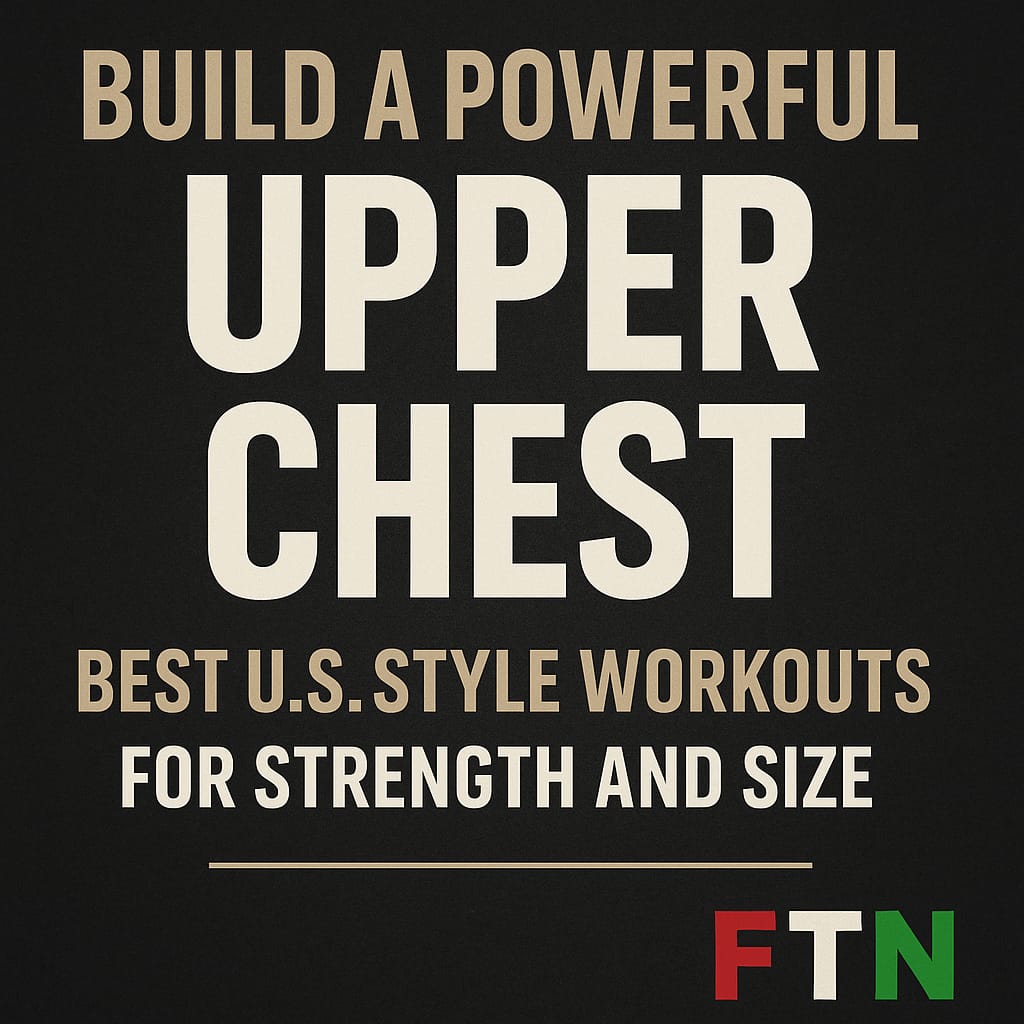🧠 Understanding the Upper Pectoral Muscle Anatomy
To sculpt a strong, balanced chest, it’s essential to understand how the upper pectoral muscles work. The upper chest is primarily composed of the clavicular head of the pectoralis major. This region plays a key role in lifting, pressing, and pushing movements.
The pectoralis major has two main portions:
Clavicular head (upper chest)
Sternal head (mid and lower chest)
The clavicular head starts at the clavicle (collarbone) and inserts into the humerus (upper arm bone). It works alongside the shoulders (deltoids) and triceps during pressing motions like incline presses, dumbbell flyes, and push-ups with an incline.
Understanding this anatomy helps athletes and fitness enthusiasts choose the right exercises to maximize muscle activation and target the upper chest more effectively. A well-trained upper chest not only enhances visual balance but also improves performance in compound lifts.
🎯 Benefits of Upper Chest Strength
Building upper chest strength offers a wide range of physical and psychological benefits:
✅ Improved Athletic Performance
Whether you’re throwing a football 🏈, swimming 🏊♂️, or lifting weights 🏋️, a strong upper chest contributes directly to pushing strength and explosiveness. It’s vital for sports and functional strength alike.
✅ Enhanced Aesthetics
A well-developed upper chest helps create that “armor plate” look—broad, full, and defined. This aesthetic is often sought after in bodybuilding and fitness communities.
✅ Injury Prevention
Stronger upper chest muscles support the shoulder joint, reducing the risk of injuries during lifting and overhead activities. Stability means better movement mechanics and long-term joint health.
✅ Boosted Confidence
Visible gains in upper chest development can lead to increased self-confidence, which fuels motivation and consistency in training and everyday life.
🔝 Top U.S.-Style Upper Chest Workouts
Here are the most popular and effective American-style exercises to build size and strength in your upper chest:
1. 🏋️ Incline Barbell Bench Press
How to do it: Set your bench at a 30–45° angle. Grip the bar slightly wider than shoulder-width. Lower the bar to the upper chest, then press upward.
Reps/Sets: 3–4 sets of 8–12 reps
Why it works: Heavy compound movement that directly targets the upper pectorals and builds overall strength.
2. 💪 Incline Dumbbell Press
How to do it: Same bench angle as above. Lower the dumbbells slowly and press them up with a chest squeeze at the top.
Reps/Sets: 3–4 sets of 10–12 reps
Pro Tip: Use neutral grip for more shoulder-friendly pressing.
3. 👐 Incline Dumbbell Flyes
How to do it: On an incline bench, start with dumbbells above your chest. Slowly open arms wide, feel the stretch, then squeeze back to center.
Reps/Sets: 3–4 sets of 10–15 reps
Why it works: Provides a deep stretch and contraction, helping carve out the upper chest line.
4. 🔗 High-to-Low Cable Crossovers
How to do it: Set the pulleys high. Bring handles down and inward toward the upper chest, focusing on the squeeze.
Reps/Sets: 3–4 sets of 12–15 reps
Pro Tip: Pause 1–2 seconds at the center to intensify the contraction.
5. 📏 Incline Push-Ups
How to do it: Place hands on a low platform. Keep body in a straight line. Lower chest to the platform and push up.
Reps/Sets: 4 sets to failure
Perfect for: Beginners or as a burnout finisher at the end of a workout.
📆 Creating an Upper Chest Workout Plan
An effective workout plan is key to building consistent gains in your upper chest.
🧩 Choose the Right Split:
Beginners: Full-body 3x per week (include 1–2 upper chest exercises per session)
Intermediate: Push/Pull/Legs split or Upper/Lower split
Advanced: Chest-specific day or two focused upper body sessions per week
🔁 Frequency:
Train upper chest twice a week, spacing out at least 48 hours for recovery.
🧱 Progressive Overload:
Gradually increase weights, reps, or tempo to challenge your muscles.
Example: Start with incline press, then progress to paused reps or drop sets over time.
🔄 Include Variety:
Rotate bench angles (30°, 45°, incline machines)
Change grip width
Mix dumbbells, barbells, and cables to activate different fibers
📓 Track Progress:
Log workouts in a fitness app or notebook
Monitor your strength gains, volume, and muscle definition over time
🍽️ Nutrition for Upper Chest Growth
Your muscles won’t grow without the right fuel. Here’s how to support upper chest development through nutrition:
🥩 Protein
Aim for 1.6–2.2g per kg of body weight daily
Top sources: Chicken breast, turkey, eggs, whey protein, tofu
🥔 Carbohydrates
Essential for workout energy and recovery
Choose complex carbs: sweet potatoes, brown rice, oats, whole grains
🥑 Healthy Fats
Support hormone production (like testosterone)
Include nuts, olive oil, seeds, and avocados
🧃 Hydration & Micronutrients
Stay hydrated 💧
Get enough magnesium, zinc, and vitamin D—vital for strength and recovery
Sample Post-Workout Meal:
Grilled chicken breast
Quinoa + steamed broccoli
Protein shake with a banana
🛡️ Avoid Injury: Train Smart, Not Just Hard
Upper chest training can be intense, so injury prevention is key:
✅ Warm Up
5–10 mins of light cardio
Dynamic shoulder and chest stretches
✅ Focus on Form
Avoid overloading at the expense of technique
Use controlled reps and full range of motion
✅ Rest & Recovery
Rest muscles at least 48 hours before hitting them again
Use foam rollers, massage, and active recovery to boost performance
📊 Final Thoughts: Chest Gains Take Strategy
A powerful upper chest doesn’t just happen—it’s the result of targeted training, smart nutrition, and consistent effort.
By following proven U.S.-style workouts like incline presses, dumbbell flyes, and cable crossovers, and combining them with a structured program, you can unlock impressive upper chest gains. Whether your goal is to look stronger, feel more confident, or simply perform better, building your upper chest is a smart investment in your fitness journey.
👉 Stay consistent. Stay patient. And always train with intent. 💥
This video does a solid job tackling one of the most common physique weak points: the upper chest. A well-developed upper chest doesn’t just complete your aesthetics — it also enhances shoulder stability and pressing performance. What makes this video valuable is how it blends smart programming with technique-focused advice.
✅ Why this video adds real value:
Instead of just throwing a list of incline presses, it breaks down the why behind each movement, emphasizing angles, tempo, and mind-muscle connection. Exercises like incline barbell presses, low-to-high cable flyes, and incline dumbbell presses are presented with clean execution and practical cues.
🧠 Coach’s Perspective:
Upper chest development requires more than just incline work. It demands attention to:
Bench angle (30–45 degrees for optimal clavicular fiber engagement)
Controlled reps (especially the eccentric phase)
Load selection that allows maximum contraction without shoulder strain
This video captures those key points and encourages viewers to train with purpose, not just power.
🔥 Practical Tip for Viewers:
To grow your upper chest faster:
Start your push day with incline movements while you’re fresh.
Include isolation work like cable flyes at the end of your workout to fully exhaust the upper fibers.
Use a slight pause at the bottom of each rep to eliminate momentum and increase tension.

